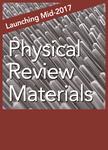版权所有:内蒙古大学图书馆 技术提供:维普资讯• 智图
内蒙古自治区呼和浩特市赛罕区大学西街235号 邮编: 010021

作者机构:Department of Condensed Matter Physics and Materials Science S. N. Bose National Centre for Basic Sciences JD Block Sector III Salt Lake Kolkata 700106 India Department of Metallurgical and Materials Engineering Indian Institute of Technology Kharagpur Kharagpur 721302 India Center for Mathematical Computational and Data Science Indian Association for the Cultivation of Science Kolkata 700032 India
出 版 物:《Physical Review Materials》 (Physic. Rev. Mat.)
年 卷 期:2018年第2卷第10期
页 面:103605-103605页
核心收录:
基 金:Department of Science and Technology, Ministry of Science and Technology, India, डीएसटी, (SR/NM/NS29/2011) Department of Science and Technology, Ministry of Science and Technology, India, डीएसटी
主 题:Plasticity
摘 要:With a goal to improve upon the mechanical properties of the MAX phase, materials of high technological interest, we explore boron substitution in these compounds. Employing first-principles density functional theory (DFT) calculations, combined with continuum modeling to access the core structure of dislocations, we investigate the effect of boron-substitution on plastic deformation properties of a typical MAX phase compound, V2AlC. Our T=0 K results show that, due to the differential nature of chemical bonding between V and B compared to that between V and C, both V-Al and V-B basal slip planes get activated in boron-substituted compounds, compared to only V-Al basal slip in the parent compound. This, in turn, makes the boron compounds significantly more ductile compared to their carbide counterpart V2AlC. The computation of temperature-dependent free energies of stable and unstable stacking faults further reveals the important and interesting role of thermal fluctuations in the deformation behavior of the boride compounds at elevated temperature. This suggests a change in the microscopic mechanism of plastic deformation upon varying temperature condition in the proposed boron compounds. Our study should motivate future exploration of boron-based MAX compounds.